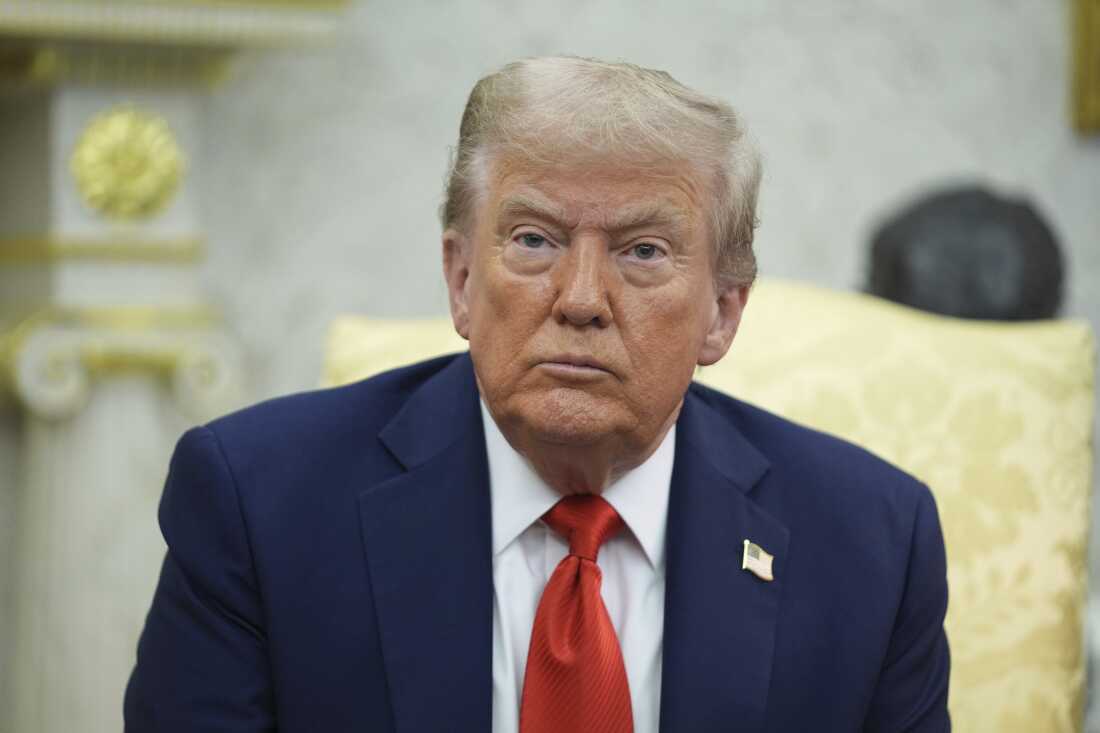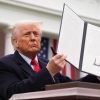President Donald Trump listens throughout a gathering with Polish President Karol Nawrocki within the Oval Workplace of the White Home on Sept. 3, 2025, in Washington.
Evan Vucci/AP
cover caption
toggle caption
Evan Vucci/AP
WASHINGTON — The Trump administration took the combat over tariffs to the Supreme Courtroom on Wednesday, asking the justices to rule shortly that the president has the ability to impose sweeping import taxes underneath federal regulation.
The federal government referred to as on the court docket to reverse an appeals court docket ruling that discovered most of President Donald Trump’s tariffs are an unlawful use of an emergency powers regulation.
It is the most recent in a sequence of Trump administration appeals to a Supreme Courtroom he helped form, and one that’s anticipated to place a centerpiece of the president’s commerce coverage earlier than the justices.
The U.S. Courtroom of Appeals for the Federal Circuit left the tariffs in place for now, however the administration however referred to as on the excessive court docket to intervene shortly in a petition filed electronically late Wednesday and supplied to The Related Press. It was anticipated to be formally docketed on Thursday.
Solicitor Common D. John Sauer requested the justices to take up the case and listen to arguments in early November.
“That decision casts a pall of uncertainty upon ongoing foreign negotiations that the President has been pursuing through tariffs over the past five months, jeopardizing both already negotiated framework deals and ongoing negotiations,” he wrote. “The stakes in this case could not be higher.”
However the stakes are additionally excessive for small companies battered by tariffs and uncertainty, mentioned Jeffrey Schwab, senior counsel and director of litigation on the Liberty Justice Middle.
“These unlawful tariffs are inflicting serious harm on small businesses and jeopardizing their survival. We hope for a prompt resolution of this case for our clients,” he mentioned.
The companies have twice prevailed, as soon as at a federal court docket targeted on commerce and once more with the appeals court docket’s 7-4 ruling.
Their lawsuit is considered one of a number of difficult the tariffs and erratic rollout which have shaken world markets, alienated U.S. buying and selling companions and allies and raised fears of upper costs and slower financial development.
However Trump has additionally used the levies to stress the European Union, Japan and different international locations into accepting new commerce offers. Income from tariffs totaled $159 billion by late August, greater than double what it was on the identical level the yr earlier than.
Most judges on the U.S. Courtroom of Appeals for the Federal Circuit discovered the 1977 Worldwide Emergency Financial Powers Act, or IEEPA, didn’t let Trump usurp congressional energy to set tariffs. The dissenters, although, mentioned the regulation does enable the president to control importation throughout emergencies with out specific limitations.
The ruling entails two units of import taxes, each of which Trump justified by declaring a nationwide emergency: the tariffs first introduced in April and those from February on imports from Canada, China and Mexico.
The Structure provides Congress the ability to impose taxes, together with tariffs. However over the many years, lawmakers have ceded authority to the president, and Trump has made the a lot of the energy vacuum.
Some Trump tariffs, together with levies on international metal, aluminum and autos, weren’t lined by the appeals court docket ruling. It additionally doesn’t embrace tariffs Trump imposed on China in his first time period that have been saved by Democratic President Joe Biden.
Trump can impose tariffs underneath different legal guidelines, however these have extra limitations on the velocity and severity with which he may act.
The federal government has argued that if the tariffs are struck down, it might need to refund a number of the import taxes that it is collected, delivering a monetary blow to the U.S. Treasury.






